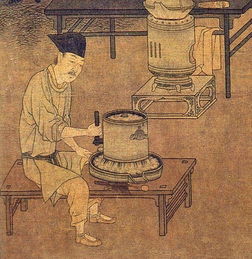古代茶叶艺术图案图片
Tea, deeply woven into the cultural fabric of ancient civilizations like China, has not only been revered for its taste but also cherished for its symbolic significance. Across millennia, tea leaves have inspired artists to create intricate patterns, both in visual arts and in the leaves themselves. Let's delve into the artistic realm of ancient tea leaf patterns.
1. Tea Leaf Art in Ancient China

Ancient Chinese artists found inspiration in the delicate veins and shapes of tea leaves. They would often arrange tea leaves into elaborate patterns, such as floral motifs, landscapes, or symbolic characters. These patterns weren't just aesthetically pleasing; they carried deeper meanings, reflecting the harmony of nature, the passage of time, and spiritual enlightenment.
One of the most famous forms of tea leaf art in ancient China was the creation of "tea flowers" (茶花, cháhuā). Artisans meticulously arranged tea leaves into intricate shapes resembling blossoms. This art form not only showcased the creativity of the artist but also celebrated the beauty of nature.
2. Symbolism in Tea Leaf Patterns
Tea leaf patterns were rich in symbolism, reflecting the philosophical and spiritual beliefs of the time. For example, the lotus flower, often depicted in tea leaf art, symbolized purity, enlightenment, and the journey towards spiritual awakening. Similarly, the depiction of mountains and rivers represented the eternal principles of Daoism, emphasizing harmony and balance.
Moreover, tea leaf patterns were sometimes imbued with auspicious meanings, especially during celebrations or ceremonies. For instance, patterns resembling dragons or phoenixes were believed to bring good fortune and prosperity, while those depicting the moon and stars evoked a sense of tranquility and harmony.
3. Techniques of Tea Leaf Artistry
Creating intricate patterns from tea leaves required skillful hands and a deep understanding of aesthetics. Artists employed various techniques to manipulate the leaves and achieve desired designs. Some common techniques included:
- Weaving: Thin tea leaves were woven together to form intricate patterns, much like fabric or basket weaving.
- Pressing: Tea leaves were carefully pressed onto a surface, such as paper or fabric, to create detailed imprints.
- Layering: Different types or colors of tea leaves were layered to produce contrasting textures and shades.
- Etching: Fine tools were used to etch delicate lines and details onto tea leaves, enhancing their visual appeal.
4. Preservation and Legacy
Despite the ephemeral nature of tea leaf art, efforts were made to preserve these delicate creations. Artists would often document their works through paintings or calligraphy, ensuring that their artistry would be remembered through the ages. Additionally, tea leaf patterns were sometimes incorporated into other art forms, such as pottery, textiles, or even architecture, further perpetuating their legacy.
Today, while the tradition of tea leaf art may not be as prevalent as it once was, its influence can still be seen in various aspects of Chinese culture, from traditional tea ceremonies to contemporary art forms. By exploring the artistic patterns in ancient tea leaves, we gain a deeper appreciation for the intersection of nature, culture, and creativity.
标签: 古代茶图片大全2015款 古代茶叶艺术图案有哪些 古代茶画作品 古代茶艺图片 古代茶叶艺术图案图片
相关文章
